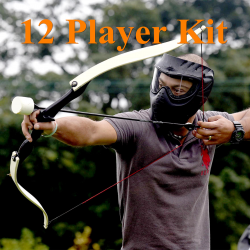Maintains posture and a comfortable position in the firing line, looks ahead, inhales and fills the lungs, straightening the body and mind; lower your chin and straighten the back of your neck as if something is pulling your head up, look sideways towards the target without lifting your chin and breathe out relaxing your body and mind, but without changing your posture, raise your arm with the bow, keeping your aim on the target, pull the rope inhaling now into the belly, aim and release wake up, wait for the arrow to hit the target and lower the arm by breathing air and relaxing the muscles. For combat archery tag this is important.
The posture

The stance can be divided into four levels:
- The feet
- The waist and the back, the lower back
- The shoulders and the back
- The head
The feet
There are several possible positions for the feet. In reality, it does not matter how you position yourself, it does not matter if you are with both feet on the ground, or only with one, if you are shooting on your knees or even turned upside down. The posture you assume during the shot is irrelevant, what matters is that you always do the same posture in every shot.
This means: if you can always repeat the same posture during each shot, this posture will be the right one for you. This is the basic rule. If you can shoot upside down and always repeat this posture with each shot, great, shoot upside down. Only for those who are not able to shoot upside down or on one foot, for such, there are certain basic rules.
These rules are a form of an initial template, to facilitate learning the logic of shooting. overtime, according to the individuality of each one, each archer will modify the basic posture according to his body.
So come on, feet:
The basic position of the feet and keep them parallel to the line of fire, and away from each other the width of the shoulder itself.
In the drawing above we can see several possible positioning of the feet:
The basic posture is, in which case the feet are parallel and aligned with the line of fire. This posture is the most stable of all and also the most neutral. The important thing in this posture is that your feet are aligned with your waist and shoulders. This is a very easy posture to be repeated, it is flexible and provides a better and easier adaptation to local circumstances like the wind.
In the second case, we have one of the feet facing outwards. Some athletes like this posture because it induces greater security and stability which is a mere illusion. The reason for this is often a certain weakness of the supporting tissues like the tendons and muscles that are shortened by the lack of stretching exercises. The posture is not wrong. The important thing is that the archer always takes the same position again after each series of shots.
In the third case, we have something very common, but it should be avoided if possible. This is a somewhat stable posture, especially when it is windy. But there are many archers who find it difficult to keep their feet parallel and so choose this posture. For such archers, expert, therefore, recommends a posture more than the second, to give a little more stability.

